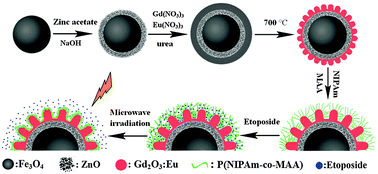A novel microwave stimulus remote controlled anticancer drug release system based on Fe3O4@ZnO@mGd2O3:Eu@P(NIPAm-co-MAA) multifunctional nanocarriers†
Abstract
The design of stimuli-responsive controlled drug delivery systems is a promising approach in cancer therapy, but it is still a major challenge to be capable of optimum therapeutic efficacy. Herein, we have elaborately fabricated Fe3O4@ZnO@mGd2O3:Eu (mGd2O3:Eu was short for mesoporous Gd2O3:Eu) multifunction composite nanoparticles by a simple process, with mesoporous Gd2O3:Eu shells as supports to increase the anticancer drug loading and thermally responsive polymer poly[(N-isopropylacrylamide)-co-(methacrylic acid)] (P(NIPAm-co-MAA)) gated mesoporous shells as microwave stimulus gatekeepers. The as-synthesized hybrid nanoparticles show a large accessible pore volume (0.19 cm3 g−1) and a high magnetization saturation value (27.8 emu g−1) for drug loading and targeting. The ZnO shells can effectively absorb and convert microwave to heat upon irradiation with microwaves, as a result of the microwave irradiation P(NIPAm-co-MAA) shrinks to a smaller volume and exposes the pores of the mesoporous luminescent shell, realizing the triggered release of the entrapped etoposide (VP16) drug (under microwave irradiation the VP16 release was about 81.7% within 10 h). In vitro studies show the multifunctional nanocarrier feasibility and advantage for remote-controlled drug release systems.


 Please wait while we load your content...
Please wait while we load your content...